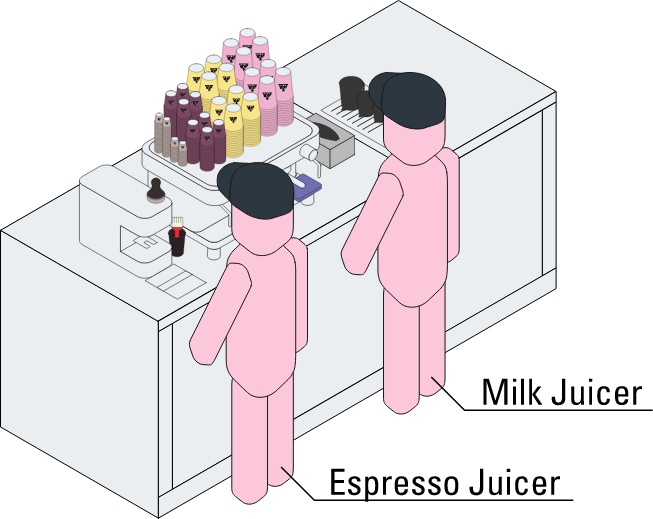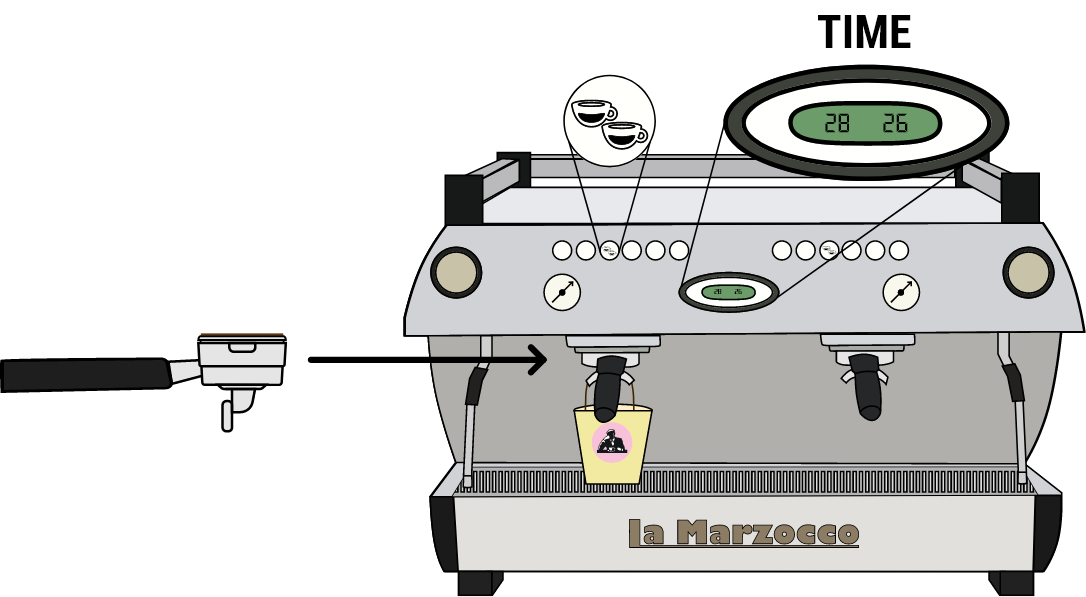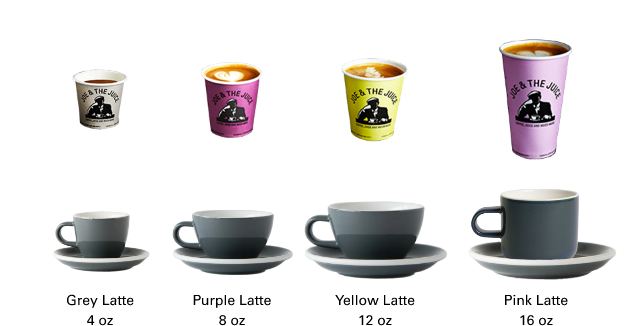How to Train
Coffee Station
The Coffee Station is where we produce all our tasty coffee products, both hot and iced. Follow the steps below when carrying out a Coffee Station training:


Certify in the "Coffee Station" section in Attensi until the dotted line:
- Video: Introduction to Coffee Station
- Game: Coffee Station
- PDF: Coffee Station Products
*Franchise Markets: Trainee to study e-Campus module

Teach the practical procedures on shift by covering all areas of this training module using the training tag: Coffee Station on WP2

The following days, the Trainee practices all training goals until they are ready for the validation.

Carry out a module validation to measure performance and celebrate growth. Plan a validation shift using the validation tag: Coffee STATION VALIDATION.
Part 1: Knowledge Validation in Attensi
The Juicer will start out by certifying in the validation modules in Attensi:
- Coffee Station Checklist
- Coffee Station Validation
Part 2: Practical Validation on shift
The Juicer will show they are capable of executing their theoretical knowledge in practice.
Part 3: Register on WP2
If the Trainee passes, register the validation as passed in WP2 and move on to the next module. If the Trainee fails, grade the validation as failed in WP2. Then, share improvement points, allow for more “Practice On Shift” and plan a new Validation Shift.

The Coffee Station
When working on the Coffee Station, there are two positions to cover. These positions can all be covered by one Juicer, or the positions can be split out between two Juicers.

Equipment Overview
The full overview of tools and equipment needed to work on the Coffee Station.
Coffee Station Walkthrough
Espresso Machine
The espresso machine controls the water used to make the extraction. The volume, temperature, and pressure can all be adjusted to increase or decrease the espresso extraction.

Grinder
The grinder increases the surface area of the coffee bean by cutting it into many small pieces so the water can easily extract all of the flavour from the coffee bean.

Puq Press
The Puq Press helps in this process by automating the tamping procedure and creates overall quality and consistency of espresso shots.

Overview of the Coffee Station












Hygiene
Clean on the Go ‘COTG’
To maintain a fast workflow and minimise the need for frequent hand washing we use Clean-on-the-Go procedures. COTG is performed with paper hand towels and sanitiser instead of using cloths and is purely to remove debris and to sanitise the work surfaces. Once the paper hand towel has been used, it must be disposed of immediately.
When there is spare time, clean other items such as pitchers, pitcher flusher, drip tray and portafilters
Hand washing
Washing hands reduces the possibility of contaminating any food products you touch. We wash our hands not only to be hygienic but also to show humbleness and respect to our guests.
When to wash your hands: You must wash your hands whenever you think they may have become dirty/contaminated.
Some examples after which you must wash your hands:
- When first entering behind the bar for a shift
- You’ve handled cash
- You enter the bar after going to the locker room or storerooms
- After a sneeze, a cough, or touching your face
- Using a cleaning cloth
- Picking something up from the floor
- After using the toilet
- Emptying bins
- After a break
- Taking a cigarette or vape break
- And MANY more! When in doubt, wash your hands.
FIFO
First in first out – FIFO is fundamental for a healthy stock handling. FIFO means “First In, First Out”. FIFO is the goods “workflow” from when we receive our goods, to which order we use them. It is important to make sure you stack up the oldest food items on top / in front. Following FIFO helps us ensure that only fresh food is used in our products.
Brand Behavior on the Coffee Station
Brand Behavior can be practiced at every station—including the Coffee Station. Here’s how to bring it to life in action:

When Mistakes Happen
Use mistakes as a chance to create a memorable experience:
- Instantly fix what went wrong—always prioritise the guest.
- Take full accountability for the mistake.
Espresso Juicer
Our Coffee
Our Coffee Philosophy
We use coffee as a tool to interact with the guests and each other. It’s almost just another excuse to be together. The goal is to create a community that stretches on both sides of the counter.
Our Coffee
Our coffee tastes amazing - but that’s not all. The exciting part is our coffee is sourced seasonally through sustainable relationships with farmers. Joe’s coffee is 100% Arabica and fully traceable where we build partnerships with local coffee roasters to ensure the freshest possible product
Our coffee is roasted towards the darker side of the spectrum – yielding a complex flavour profile with notes of dark chocolate and cherry, balanced with acidity and sweetness.
Espresso
Espresso is a process of brewing coffee and is made by forcing pressured hot water through very finely ground coffee beans.
Espresso Procedure
1. Preparation: Take out the portafilter and flush the group. Wipe the basket clean with a dry cloth or paper towel.
2. Grind: Insert the portafilter into the grinder and grind a dose of coffee

3. Tamp: Level the coffee by tapping the basket area of the portafilter with your palm and tamp the coffee.

4. Extraction: Insert the portafilter in the group and press the double shot button.

5. Finish the Coffee: When the espresso is done pouring, finish the coffee and tap it out on The List.
6. Clean on the Go: After the Coffee has been tapped out, perform Clean on the Go by taking out the portafilter and knocking out extracted coffee, clean the portafilter and purge the group head before inserting the portafilter back into the group. Finally brush away excess coffee and wipe the countertop clean with a paper towel.
Milk Juicer
Hot Water Based Coffee
To make Americano & Tea we add hot water.
This can be done in two ways:
Stores that has a Marco Hot Water Boiler: Press the hot water button to fill up the cup
Stores that doesn't have a Hot water Boiler: Steam the water to 85°C
Milk Based Coffee
Steam the Milk
The Stretch
To make Latte, Flat White, Cappuccino, Macchiato we stretch the milk to add texture and volume.
Tip: You can practice "The Stretch" procedure with water before trying with milk to get more comfortable using the steam wand.
The Procedure
1. Choose Pitcher: Choose the pitcher corresponding to the cup size & fill the pitcher just under the beginning of the spout with the guest's choice of milk

2. Place the Steam Wand: Place the steam wand just under the milk surface in the pitcher “In the middle and a bit to the left”

3. Give the Milk Air: Slowly open the steam pressure until the milk spins in a controlled circular direction
Keep the tip just below the surface to control the aeration and volume.
If your steam wand is in the right position you should hear a gentle ‘schsch’ hissing sound.
Give the milk a total of “3 seconds of air” - Air = gentle ‘schsch’ hissing sound

4.Whirlpool: Submerge the steam wand deeper into the milk to create a whirlpool and keep the jug in the same position to maintain the whirlpool

5. Temperature: When your fingers can no longer hold on to the base of the jug, let go and turn the steam valve off.
Keep the steam wand submerged until it’s completely off.
6. Clean on the Go: Purge the Steam Wand and wipe it clean with the designated cloth. Flush away excess milk from the pitcher in the can flusher.
The Pour
Pouring latte art is complex and it will take a lot of practice before you can make the designs consistently good - no worries, you got time.
Latte art is divided in 3 different stages, the base, the design, and the slice.

How it looks in practice:
If you want to learn more about Latte Art visit the Latte Art section of the Coffee Universe here:
https://e-campus.joejuice.com/coffee-modules/latte-art

How to serve coffee

Serving in Porcelain Cups

GREY LATTE:
4 oz- Used for espresso and espresso macchiato
PURPLE LATTE:
8 oz- Used for flat white
YELLOW LATTE:
12 oz - Used for latte and cappuccino
PINK LATTE:
16 oz - Used for latte and tea
Dial In
If the run-time of the coffee is not between 25-30 seconds, we perform what is called a Dial In.
SHORT RUN-TIME: Less intense and sour
LONG RUN-TIME: Very intense and bitter
IDEAL RUN-TIME (25-30 SECONDS): Balanced flavour between sourness and bitterness
How to perform a dial in:

Find Dial in for Major Mazzer & Mythos 1 here:
How to videos
Validation Checklists & Cheat Sheets
These tools support in-store training by making learning clear and consistent.
- Validation Checklists track progress and ensure key procedures are trained and completed.
- Cheat Sheets give a quick overview of our products and how to make them.
Together, they help new Juicers build confidence and get up to speed faster.
IMS Sheets Coming soon!
Download and print-out for your market here:
Cleaning Tasks
















.png)

















































